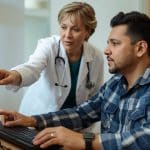
Emory Ford
My primary care physician motivated me to share my story, which is perhaps best described as an unfinished journey. What started to be a typical runner’s problem morphed into dealing with limited personal mobility with neuropathic pain and loss of sensation.
I was unprepared for the challenges this journey presented. The loss of mobility has been extremely frustrating. The ambiguity in finding the root cause of the problem(s) is and has been less concerning than dealing with the loss of mobility. I am not sure how one could prepare for such a journey.
I am 85 years old, and enjoy being physically active and mobile, including running. Science is both a vocation and an avocation for me. As an active scientist for more than 50 years, I have the expectation of being able to understand problems and predict outcomes. I appreciate that understanding a problem takes time and that more than one outcome is possible.
Four years or so ago, I experienced knee pain and was advised to see an orthopedist. After undergoing an MRI and x-rays, I was advised to reduce my running and supplement it with biking.
While I continued to run, I noticed emerging problems with my gait and occasional balance problems. Running became no longer possible or fun. A course of PT was recommended, which I completed.
Because the gait issues continued, I was referred to a neuromuscular neurologist who recommended the use of a type of brace called an ankle-foot orthosis (AFO) to mitigate balance problems. A recommendation was also made to see a podiatrist to ensure there were no foot problems. I had an exam and x-rays that ruled out foot problems.
As my problem progressed, running and biking were no longer possible, but the AFO enabled me to remain mobile and active. Walking on uneven surfaces became increasingly difficult, but was possible with a cane or walking sticks.
Balance and gait problems continued. Electromyography (EMG) tests revealed the loss of nerve conduction in both legs. This led to surgical decompression of the nerves of both legs, near the knees, followed by physical therapy starting with a walker and then with a cane.
Since nerve growth is slow, any improvement was expected to be slow. After 6 months, a second set of EMG tests revealed no improvement in nerve conduction and no improvement in balance or gait.
My primary care physician recommended additional follow-up with a neuromuscular neurologist. A comprehensive set of blood tests was ordered. Despite the surgery, repeat EMG-confirmed nerve conduction problems in both legs and revealed similar issues in my upper body, which came as a big surprise.
The blood screening tests suggested an autoimmune condition causing demyelination of the nerves. Follow-up with a hematologist confirmed this after an additional set of blood tests. Tests indicated a rare autoimmune condition, reported to be 2-3 in a million.
The hematologist recommended a Rituximab infusion to control the autoimmune disease. Rituximab is a monoclonal antibody that modulates the immune system. It is used to treat many autoimmune diseases and some cancers. The hope is that it would prevent further disease progression and possibly restore better balance and gait.
My problems with balance and mobility had increased with time, but I was able to manage and mitigate some of those problems. However, when the additional EMGs revealed unexpected deterioration of nerve function in both of my arms, I was both surprised and disturbed at the prospect of losing both mobility (impacting my active lifestyle) and manual dexterity (impacting my basket weaving). It recalled for me a memory of seeing my grandfather, a stroke victim, who lost all mobility and dexterity, including loss of speech. There was little my grandfather could do.
I decided that the best course of action for me was to accept the recommendation of a suggested infusion in the hope of arresting further nerve deterioration. After all, the risks of the medication were minimal (other than the cost to Medicare) and the potential benefits were large. However, I was mindful of the possibility of further loss of mobility and dexterity.
Hoping for the best but preparing for the worst, I planned to continue being as active as possible, but also to investigate new activities that demand less mobility and dexterity.
The first infusion was completed. At this writing, I am waiting to see the long-term results, both in blood chemistry and function. At this point, my mobility has stabilized, but a cane is required; so far, basket weaving is still possible.
During this personal “saga” I have had significant contact with a variety of caregivers and providers. My hospital, which provides most of my care, has a patient portal through which I can see my test results in a timely way. I find that helpful in reducing uncertainty and anxiety.
However, the online data doesn’t put things in context to paint the larger picture. I suspect many would not find the data helpful. As a scientist, data analysis has been a part of my life, but understanding medical data is not easy. I have support from family members with a medical background, which helps me understand my medical situation.
I think many people can understand the idea of the probability of success of a procedure and can deal with it. Although I encountered some providers who were initially reluctant to provide an estimate of the probability of success, when pressed, all my providers did provide estimates and were able to discuss the downsides of treatment.
I have written this to share my four-year experience with a medical problem that produced frustration, uncertainty, and ambiguity, for both the care receiver (me) and care providers. I avoided many of the medical details because I think the story of struggling with a problem may be just as important as all the medical details.
This experience holds a certain fascination for me. As a scientist, I found myself with a difficult-to-diagnose medical problem with an uncertain treatment. It’s like being a guinea pig, a personal body experiment. I owe thanks to my providers for their patience with my questions and my insistence on numbers.
In addition to support from my professional medical caregivers I am fortunate to have the support of my family, especially from my wife. She has been patient dealing with my decreased mobility. During this saga, I had unexpected surgery for a necrotic Meckel’s diverticulum. She patiently gave me daily heparin injections at home after surgery, while supporting me while I was hobbling around with a walker, recovering from both Meckel’s surgery and from the nerve surgery on my leg. Our daughter is a physician, and she provided support for both me and my wife. I am thankful for family support; I cannot imagine making it without that support.
My experience suggests that dealing with an unusual and infrequently encountered medical situation is challenging for both the patient and their healthcare professionals. Mutual participation and discussion with my clinicians has been key to helping me meet the challenges.






That is a. Impressive report and perspective. Being a statistical outlier has many challenges and sometimes off opportunities. Glad you have a positive outlook.